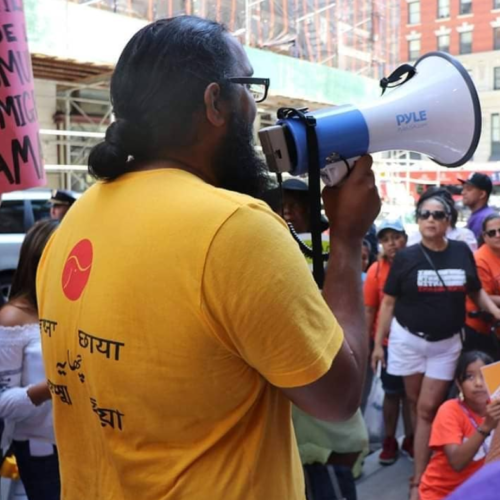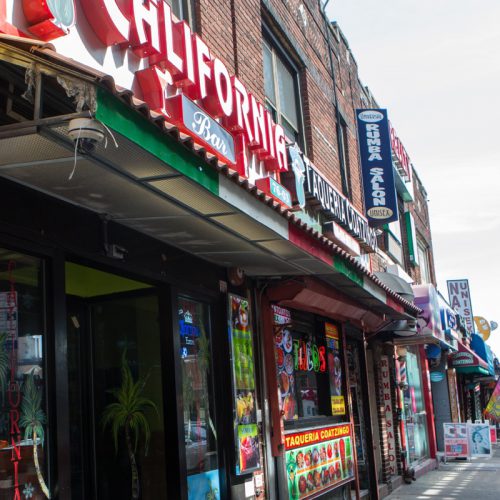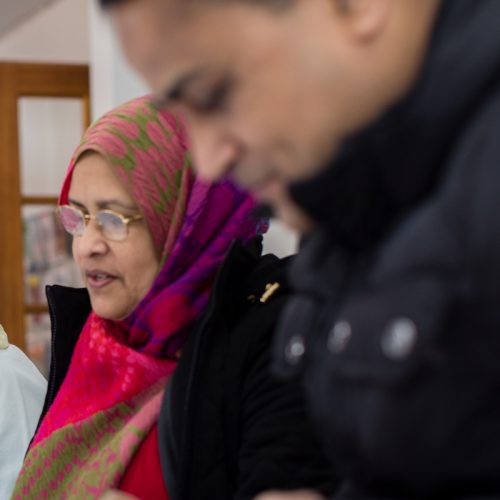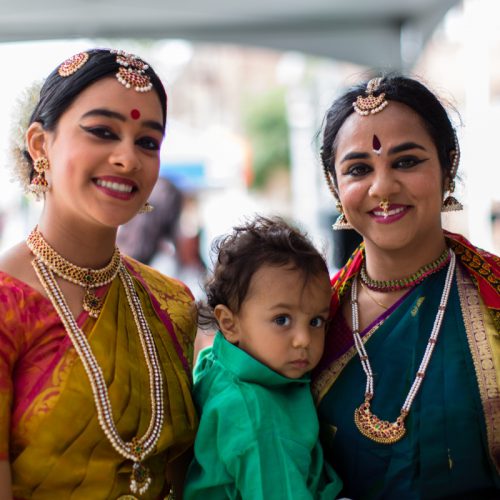
Support Chhaya CDC in building the power, housing stability, and economic well-being of South Asian and Indo-Caribbean communities in New York City. Donate Today!

Media Advisory:
MediaAdvisory_ ED of Chhaya CDC to Testify in Congress 3_1_22 (PDF)
Watch the Full Hearing here.
Wach Annetta’s Cut here.
Written Testimony – Annetta Seecharran (PDF)
Testimony of Annetta Seecharran
Executive Director
Chhaya CDC
Before the House Judiciary Subcommittee on the Constitution, Civil Rights, and Civil
Liberties
“Discrimination and the Civil Rights of the Muslim, Arab, and South Asian American
Communities”
March 1, 2022
Chairman Cohen, Ranking member Johnson, and members of the Constitution, Civil Rights, and Civil Liberties Subcommittee, my name is Annetta Seecharran. I am the Executive Director of Chhaya CDC.
Thank you for the opportunity to speak before you today on “Discrimination and the Civil Rights of the Muslim, Arab, and South Asian American Communities.” I am grateful to the countless individuals and organizations who advocated for this hearing to take place today. This hearing must be the first of many that occur in the halls of Congress and in state legislatures around the country to understand the full breadth of the issues facing our diverse communities.
I am an immigrant from Guyana who moved to the United States at a young age and have always been actively involved with South Asian and Indo-Caribbean communities in New York City. My testimony today is based on my work with South Asian communities in New York City over the past two decades through two formidable crises. When 9/11 happened, I was the executive director of South Asian Youth Action (SAYA!), the only youth development organization in the country dedicated to serving South Asian youth. Over the course of the pandemic, I have been serving as the executive director of Chhaya CDC, a Queens-based nonprofit that advocates for systemic changes that remove barriers to housing stability, economic mobility and well-being for South Asian and Indo-Caribbean New Yorkers. Over the past twenty years, I have witnessed how our communities are confronting a myriad of challenges, layered on top of crisis after crisis.
Looking back at the 9/11 attacks and its aftermath brings up many emotions for me. As a New Yorker, the attacks left me stunned and shaken to my core. I had multiple family members who worked in or near the World Trade Center. My cousin was nearby when the plane hit the South Tower, where her husband, Alfred, worked. She rushed towards the building with the hope of rescuing him but then saw the building collapse in front of her. She ran for blocks without her shoes to save her own life, hoping that her husband had survived. For days, we searched hospitals to find Alfred. We never did.
Yet, at a time of heart-wrenching grief, we found that we were also targets of verbal abuse and attacks. Days following the collapse of the towers, my family went to Saint Vincent’s Hospital with the hope of finding Alfred. There, people shouted “This is your fault” at us. Later, at the Yankee Stadium memorial service for 9/11 victims, my mother was told, “Get out of this country.”
Our experiences reflect the double grieving that many South Asians, Muslims, Arabs and Sikhs endured in the hours, days and months after 9/11. We grieved for the terrible losses on that day. And, we grieved because we knew that a backlash was on its way, targeting and scapegoating our communities for the attacks, rooted in Islamophobia, white supremacy and xenophobia.
This backlash manifested in different ways, from interpersonal violence to state policies that led to arrests, detentions, and deportations. Young Hindus, Muslims and Sikhs who visited SAYA!’s community center shared how they were being followed by law enforcement, how they were afraid to take the subway or fly, and how they were being bullied at school. Muslim girls attending our programs expressed how their hijabs were touched and grabbed in school.
But this wasn’t all. Our communities also experienced targeting by the state and federal government during the War on Terror. Across New York City, we heard about how our safe spaces – gurdwaras, mosques and temples, small businesses, and local community gathering places – were under scrutiny. As policies such as special registration, interrogations and surveillance began to unfold in New York City and around the country, our communities felt even greater fear and anxiety. As a result, small businesses in places like Coney Island Avenue in Brooklyn shut down. Mothers had to hold their families together as husbands, brothers and sons were deported. Community members experiencing hate violence on the streets or bullying in schoolyards were hesitant to report to law enforcement because they were afraid they would get caught up in a terrorist investigation. People became worried about doing the most routine activities – eating at South Asian restaurants, going to Muslim schools and visiting public parks to play cricket – because of the New York Police Department’s surveillance infrastructure.
There is a myth that the post 9/11 backlash was limited to the weeks and months immediately following the attacks. This is simply not true. In fact, in a report on South Asian New Yorkers published by South Asian organizations in 2012 – more than ten years after the attacks – young people shared their stories of being targeted by interpersonal and state violence1. An 18-year-old Hindu male from Jackson Heights, Queens recalled the impact of being singled out at his school. He said: “I was arrested by a School Safety Agent in Flushing, Queens, in 2009. I was searched … [and] questioned. The tone of the conversation was aggressive and hostile. I was scared.” A Bangladeshi 18-year-old shared his worries about being arrested: “While it was happening, I was just always scared of the outcome, like, would I go with them and sit in [the] back of the car in handcuffs? And it would go up on my record as I’m trying to get a job.”
These two stories reveal just the surface of the large-scale effects of what happened in the wake of 9/11. The cumulative impact of two decades of interpersonal and state violence is tremendous. The general feeling of being an outsider in America increased disproportionately for South Asians and Indo-Caribbeans in the wake of 9/11. As a result, young people made different educational and vocational choices. Many experienced heightened isolation, depression and anxiety which are still sources of trauma today, two decades later.
Echoes of the 9/11 backlash reverberated in the lead-up to the 2016 election. During that time, then presidential candidate Donald Trump used divisive language to describe immigrant and Muslim communities. It had a direct impact. At Chhaya CDC, we received a threatening letter and our staff were concerned for their safety. We weren’t alone. In a 2018 report, South Asian Americans Leading Together (SAALT) documented 207 incidents of hate violence and xenophobic rhetoric aimed at South Asian, Muslim, Sikh, Hindu, Middle Eastern, and Arab communities in the year leading up to the 2016 election2. Even after the election, our community members continued to experience harm at multiple levels. The Muslim ban, the denial of rights to LGBTQ communities, the immigration raids and the mistreatment of asylees and refugees all exacerbated the outsider status that South Asian immigrants were already experiencing in the United States.
There is a through-line between the post 9/11 environment and the current status of many South Asian immigrants in New York City and around the country. Government agencies did not invest adequate resources in South Asian communities to ensure our well-being, economic security and access to critical social services despite the tremendous needs in the wake of the 9/11 attacks. Instead, government resources and funds were allocated towards profiling and surveilling our communities. These decisions have caused devastating consequences.
Today, even as South Asians are one of the fastest growing immigrant groups in the country, many continue to confront tremendous challenges. The model minority myth, often used to prop up our communities as a racial wedge, erases the real disparities and vulnerabilities many members face. According to census data, there are 5.4 million South Asians living in the United States with ancestry from Bangladesh, Bhutan, India, Nepal, Pakistan, Sri Lanka, the Maldives, and the diaspora, including Trinidad and Tobago, Guyana, Fiji, Tanzania, and Kenya3. The New York City metropolitan area, where I live and work, is home to the largest South Asian population in the country. In New York City, the fastest-growing Asian groups are from Bangladesh and Pakistan, and Indians are the second largest Asian population. There is great socioeconomic and educational diversity within the South Asian community which means that it should not be treated as a monolith for purposes of programs and policies. For example, in New York City, Nepali immigrants have the highest rate of uninsurance and have the highest share of people living in households with mixed immigration statuses. Bangladeshi and Pakistani immigrants have the highest poverty rates (32% and 29%, respectively) compared to groups with the lowest poverty rates.
Our work at Chhaya CDC supports census data that Bangladeshi and Pakistani immigrants are more than twice as likely to live in overcrowded housing (46% and 44%, respectively). I have seen this first-hand at Chhaya CDC where we counsel and organize community members around housing and economic justice issues. Every day, we hear stories of community members dealing with unscrupulous landlords, struggling to pay rent, losing their jobs and small businesses – all the while navigating a climate of bigotry and experiences of isolation. In the wake of the pandemic, an already challenging situation became much worse. In my neighborhood of Jackson Heights, which became the epicenter of the pandemic in 2020, clothing and grocery stores were shuttered. The sounds of lively conversations were replaced with the sirens of emergency vehicles. Over the past two years, our staff at Chhaya CDC have counseled and supported community members to navigate the morass of local, city, state and federal regulations around health and safety, loans, restaurant revitalization, paycheck protection and more. Given the large numbers of Bangladeshi and Pakistani immigrants living in overcrowded housing, COVID-19 infection rates spread quickly, and yet, it was difficult to receive timely and appropriate attention from government agencies.
As a result, community service providers and organizers have had to step in. Even though South Asian organizations are under-resourced in New York City, we have had to provide the support that our communities need, from crisis to crisis. In Queens, Desis Rising Up and Moving organizes working-class South Asian and Muslim immigrants, Adhikaar works with Nepali-speaking communities, and Jahajee Sisters address issues facing Indo-Caribbean communities.
Yet, this patchwork of South Asian organizations is insufficient to address the vast challenges in our communities, particularly because we are often on the frontlines of crises. In the wake of national crises, we must move through several phases: recovery, redress, reinvestment, and reconciliation. When it comes to 9/11 however, we seem to have barely scratched the surface of this process, even though it’s been 20 years. Congress can take steps including:
Changing the political discourse. It is vital for elected leaders in particular to raise your voices against hateful policies and rhetoric at every turn, and instead model the type of discourse that we should be utilizing in a country that is more diverse than ever before in its history.
Providing Opportunities to Repair and Redress. Our communities deserve redress from our government, from acknowledgments to investments in the long-term well-being of community members. We have a strong precedent in the way that the US government began to make amends for its mistreatment of Japanese Americans during World War II. Redress can take many forms but it is a vital component of the process of repairing and rebuilding. Legislators and government agencies must acknowledge the harms that have been done to our communities over the past two decades due to the War on Terror. Legislators must investigate local and federal law enforcement agencies to better understand how surveillance mechanisms were utilized to target community members – and put an end to them. Government agencies must invest in restorative justice and preventative practices that address the root causes of interpersonal violence.
Invest in the Well-Being of Communities Affected by the 9/11 Backlash. We know that in the aftermath of 9/11, local, state and federal authorities allocated resources towards policing, surveillance and profiling of South Asian, Muslim, Sikh and Arab communities. Instead, government agencies should make long-term investments towards social services, recreation, education, and neighborhood programs, cultural and community spaces, health clinics, senior centers and parks, all planned and designed with the involvement of community members.
Ensure that Services are Accessible for Immigrant Communities. At every level, government agencies must provide culturally and linguistically appropriate and accessible services for our community members. Instead of solely relying on community-based organizations, government agencies must shoulder the responsibility of enacting and implementing equitable policies that secure access to health care, education, restorative justice programs, affordable housing, and mental health services.
Change and Implement Equitable Immigration Policies. Congress must find pathways for citizenship for undocumented immigrants. South Asian communities are affected by every aspect of immigration law, from DACA youth to H1B workers. Congress must ensure that Nepali immigrants must be covered by temporary protected status and be placed on a pathway to citizenship and that Afghan refugees are able to build lives in the United States. We must also end the criminalization of all immigrant communities and pass a national domestic worker bill of rights.






Main Office:
37-43 77th St, 2nd Floor, Jackson Heights, NY 11372
Contact: 718.478.3848; info@chhayacdc.org
Press: press@chhayacdc.org
Richmond Hill Center:
121-18 Liberty Avenue, 2nd Floor, Richmond Hill, NY 11419
Contact: 718.374.3371; info@chhayacdc.org
Press: press@chhayacdc.org
Copyright 2022 by Chhaya Community Development Corporation. All rights reserved. Chhaya CDC is a 501(c)3 non-profit organization.